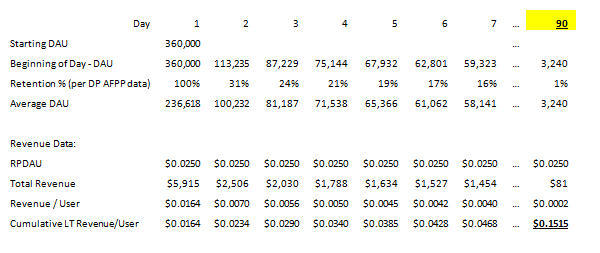Lifetime value: bringing it all together
Matt Tubergen heads Recharge Studios, a wholly owned subsidiary of W3i that invests in the development and marketing/distribution of freemium mobile games. W3i is a market leader in distributing and monetizing apps with over 500 million apps distributed for W3i clients. Recharge Studios is actively seeking new investment opportunities, if you have a great idea for a game contact us.
In this series, we’ve been examining the elements needed to accurately calculate the lifetime value of a freemium gamer. We explored the methods to calculate both Revenue per Daily Active User (RPDAU) and Retention which allows us to calculate the average daily active user (ADAU).
To review, RPDAU is how much money you are making divided by your daily active users, while retention is a key metric that speaks to how many users stick with your app day to day after initially being acquired.
One million downloads, 5 million downloads, 10 million sessions, thousands and thousands in virtual goods. Whoopee! All the metrics that draw headlines don’t do much to your bottom-line if you’re missing the foundation. When you start thinking freemium gaming, you must think in terms of lifetime value for each acquired user.
Revenue
Revenue, for the sake of simplicity can be viewed as the
average daily active user (ADAU) x revenue per daily user (RPDAU) for day 1 + day2 . . .etc.
Lifetime value
Now, to calculate the estimated lifetime value one must project out future retention (or attrition) rates for a minimum of 90 days. Do your best to look at the existing data you have to draw a picture on what your existing data represents, if you have 7 days of data that points to a steady attrition rate of 10% after day 7, don’t assume that the following days will be 2%. After you have projected your long tail attrition rate you can start to calculate total revenues and LTV based on known RPDAU. Once you have projected your 90 day retention rates, you can calculate total revenue from projected RPDAU per day for the next 90 days.
To represent this model in a calculation, one might use the following below:
(ADAU Day 1 + RPDAUDay 1) + (ADAU Day 2 +RPDAU Day 2) + . . . carried through the life of users in total days. In this example, we recommend using 90 days.
The grid below is a sample based on the calculation above lifetime Revenue per user based on 90 day period.






 freemium games
freemium games 